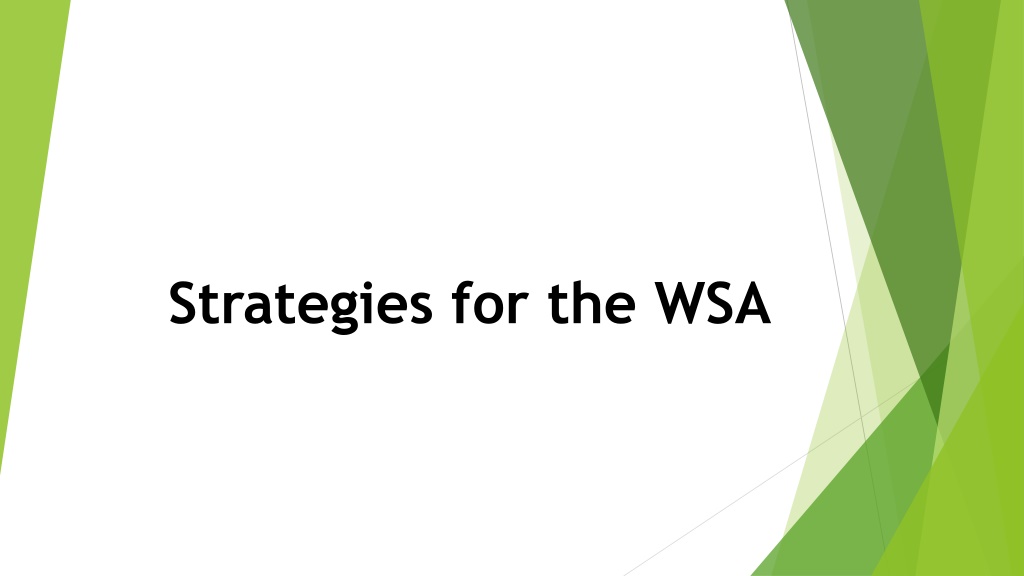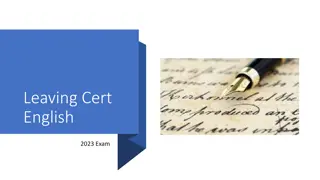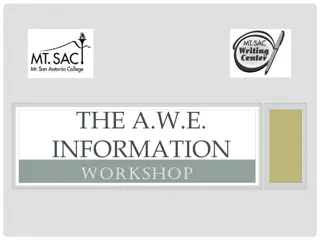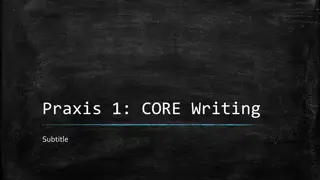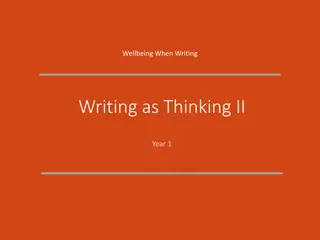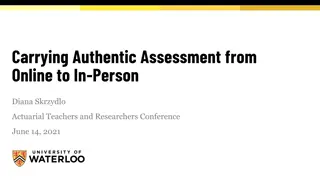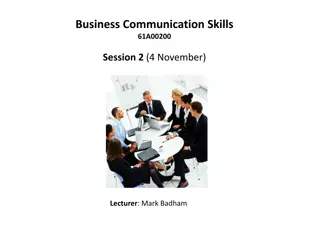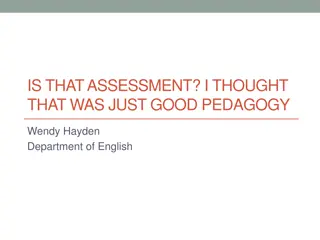Effective Strategies for Writing Skills Assessment (WSA) Preparation
Enhance your WSA preparation with strategies like analyzing prompts, outlining solutions, and practicing persuasive writing. Understand your role, audience, and task to craft effective letters or memos. Utilize example prompts and engage in mock debates to strengthen your argumentative skills.
Download Presentation

Please find below an Image/Link to download the presentation.
The content on the website is provided AS IS for your information and personal use only. It may not be sold, licensed, or shared on other websites without obtaining consent from the author. Download presentation by click this link. If you encounter any issues during the download, it is possible that the publisher has removed the file from their server.
E N D
Presentation Transcript
Goals for Today: Persuasion Task strategies Break down the Position Task Mock debate for developing Position Task arguments and counterarguments
Example Prompts Practice WSA prompts from UW Tacoma UW Bothell WSA prep PDF
Persuasion Task Scan the text for the problem your audience your role and task
The problem Look for what the characters want and the obstacles to their goals make a note of them Look for direct questions posed circle or note them as well
Your Roletypical phrases You have been hired as . . . Taking the role of . . . In the role of . . . As the [job title] of [Company X], write
Your Task write a letter = more personable write a memo = more businesslike compose an e-mail = could be either style: depends on the audience
Your Audiencesome key phrases Write a letter/an email to [Name] Write [Name] a letter/email Write a memo to [job title of a person]
Read thoroughly Use this reading to gather argument fuel Note or underline specific elements that may support and/or counter your arguments
Outline solution and opposition For every point for your argument, have an illustration For each question your reader could have, prepare a response Annotated Examples
Write Persuasively Even though letter or memo, no greeting Your reader needs to trust your persona: you are a good sibling, an ethical employee, a reasonable manager, etc. Establish trust with something concrete. Remember when I steered you away from buying that car, and two weeks later it was the subject of a nationwide recall? This situation is very similar in that . . . In my years at Company B, I ve resolved conflicts that threatened to impact . . .
Address Skepticism with Solutions You might think you have no experience in this arena, but look at everything you ve done so far that is preparation . . . While it s true that other departments are cutting their staffing and reducing their services, our department can afford to hire one new person and open one hour earlier by ending the unprofitable practice of . . .
Invent, but fit the story (examples) If the prompt only says you re a brother or sister asked for advice, then invent a qualification that can help your credibility or solve the problem If the scenario mentions Boss X s niece, but not the kind of relationship they have, you could invent their family dynamic to help your argument.
Review and Proofread Make sure all your paragraphs match your argument Scan first and last sentences for logical progression of ideas Conclude with a statement Proofread for varied sentence structures, subject-verb agreement, plural and singular clearly marked, and periods end sentences.
Pre-writing for Position Essay Framework Stance Opposition Rebuttal
Framework Define what the prompt means and what it doesn t mean This creates the framework for your stance
Stance = Position You don t have to actually believe the stance you take, just argue it well! Explain why you agree, don t agree, or would agree if certain changes were made to the prompt statement.
Give examples Illustrate your reasons with examples Real-world events Personal experiences Concrete scenarios
Opposition: What would an opponent say? For every point you raise in support of your stance, consider a well-reasoned opposition to it Don t create straw-man counterarguments: use strong, realistic opposition
Rebuttal Well-reasoned responses against opposition Add further argument in favor of your stance Annotated Examples
Key Elements of Writing Not quantity Quality is valued most Purposeful paragraphs Topic sentence Concrete illustrative examples Arrive at a conclusion/Make a point Each new paragraph relates to the ideas before it Varied sentence structures
Revise Make sure your thesis and topic sentences relate logically and lead to your conclusion.
Proofread Know your weaknesses to prioritize your focus. It s basic but essential: make sure sentences start with capital letters and end with periods. Make sure he refers to a male-identified person, and she to a female-identified person, and they to two or more people or things. Make sure the verb following which or that fits the noun giving the pronoun its meaning.
Position Essay Development as a Debate 1. Form Pro and Con teams 2. Choose from position statements
Practice Position Statement Directions: Write an essay in which you agree or disagree with the following statement: A. The recent decline in manners is having a serious impact on today's society. or B. The key component of being successful in leadership is the ability to make confident decisions. *Practice prompts by Kelvin Keown, English Language Consultant at the Teaching and Learning Center, UW Tacoma; this prompt is an unofficial practice prompt, and its author has no affiliation with the Milgard School of Business
Pros and Cons Pro side: How is the statement true? What examples could illustrate or explain the ways the statement is true? Con side: What do you think makes the statement false? What reasons or examples do you have for disagreeing with the statement? Take a few minutes to develop your ideas for only your team s perspective.
Take Turns Looking at Both Sides Pro side: Present argument, then take notes on con side Con side: Take notes on pro side, then present your argument
Consider the opposition Pro side: What did you hear? Respond to the specifics of the con argument with a counterargument. Con side: What did you hear? Respond to the pro counterargument.
Conclusion Pro side: What have you decided from this exchange of ideas? What keeps you coming back to agreeing with the statement? Con side: What have you concluded? What brings you back to disagreeing with the statement?
Have a plan Saves time Keeps writing focused Makes writing more thorough
Manage your time In case phones are forbidden, have a timepiece other than your phone The more time you spend preparing and writing, the less you should spend on proofing, and vice versa
Responses should include Your argument stance/thesis Reasons/illustrations/examples Counterarguments Rebuttals They can be structured according to the style of the writing asked for in the prompt in the way you want: creativity is encouraged!
Highlights and Take-Aways There is no single right answer or structure to the position or persuasion prompts just be thorough Avoid repeating much prompt info Focus on effective argument techniques
References and Resources Annotated Example WSA Essays from the UWBothell WSA prep PDF. [Word document.] civilianglobal. Student Profile: Elizabeth Rodland, WSA Overview, and Sample Prompts. APLUS USA. [Blog entry]: https://aplususaseattle.wordpress.com/ 2015/12/18/student-profile-elizabeth-rodland-wsa-overview-and-sample-prompts/ Accessed February 8, 2016 Practice WSA prompts from BLC handout Practice WSA prompts from UW Tacoma: https://www.tacoma.uw.edu/ sites/default/files/WSA%20Practice%20Tests.pdf UWBothell WSA prep PDF: http://www.uwb.edu/babusiness/admission- requirements/assessment
